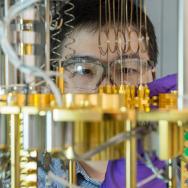The U.S. Department of Energy has announced the renewal of the Midwest Integrated Center for Computational Materials (known as MICCoM) for another three years at $3 million per year. Founded in 2015, the center is headquartered at Argonne National Laboratory. Partnering universities include the University of Chicago, University of Notre Dame and University of California, Davis.
“The MICCoM team has been at the forefront of developing simulation methods and codes and solving cutting-edge materials science problems,” said center director Giulia Galli, a senior scientist in Argonne’s Materials Science Division and professor in the Pritzker School of Molecular Engineering and the Department of Chemistry at the University of Chicago.
The use of theory and computation plays a central role in the design of new materials for applications in diverse fields. The MICCoM mission is to apply theoretical methods and software to the understanding, simulation and prediction of the properties of materials at the atomic and molecular scale.
To that end, MICCoM develops and disseminates a host of interoperable computer tools. It also establishes the validity of theoretical models and codes for determining the characteristics and behavior of materials.
Another part of its mission is providing searchable materials data that are reproducible with small margins of error. This is an increasingly pressing need in the age of artificial intelligence and machine learning.
“In the last eight years, MICCoM has positioned itself to be a sustained innovation factory for new simulation strategies to solve materials science problems,” Galli said. “We have also been providing exemplary open-source software, data and validation procedures to the scientific community.”
Materials for quantum computing
At its founding in 2015, the Center focused on new materials for energy conversion, including nanoparticle-based solids for the conversion of sunlight into energy. Starting in 2019, MICCoM began working on the modeling and simulation of materials for quantum technologies. This strategic emphasis presents an opportunity to leverage the extraordinary behavior of nature's smallest scales to discover groundbreaking materials for quantum computing, sensing and communication.
In the next three years, MICCoM will also emphasize energy saving by designing materials for low-power microelectronics. There is an urgent need for new computational pathways to materials and devices that will lead to more energy-efficient microelectronics. This research endeavor not only supports the U.S. leadership in microelectronics research but also could reinvigorate the semiconductor manufacturing industry.
“The scientific community has greatly benefitted from the computational capabilities developed by MICCoM, including Argonne itself,” said Amanda Petford-Long, director of Argonne’s Materials Science Division. “As one example, MICCoM modeled spin defects, with potential applications as qubits, to understand their formation. I am also very excited that the mission of MICCoM now extends to include low-power microelectronics. We will greatly benefit from their research.”
Expertise on water research
In addition, MICCoM has provided expertise and codes to the Advanced Materials for Energy-Water Systems Center. The mission of this Energy Frontier Research Center at Argonne is to conduct research on water-solid interfaces that will help ensure the availability of clean water and allow the extraction of critical resources from water.
Moreover, MICCoM has actively contributed to Q-NEXT, a U.S. Department of Energy National Quantum Information Science Research Center headquartered at Argonne. MICCoM codes are being used to simulate the behavior of materials in controlling and distributing quantum information.
“Equally important, we are training the future workforce in computational materials science,” Galli noted. To that end, the MICCoM team mentors students and postdoctoral appointees, organizes workshops, develops online tutorials and teaches innovative classes.
–Adapted from an article by Joseph Harmon published by Argonne National Laboratory.

